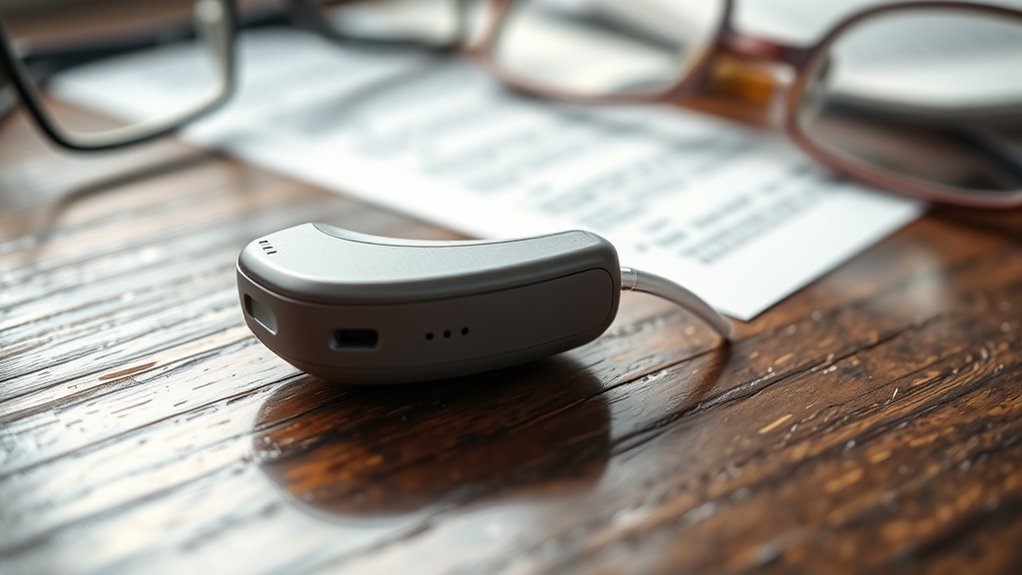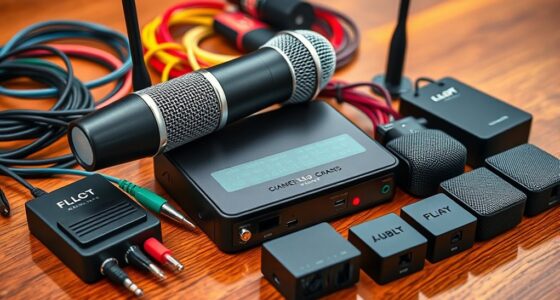In 2022, the FDA launched new regulations to make over-the-counter hearing devices safer and easier for you to access. These rules require clear labeling, safety standards, and certification for approved products, so you can make informed choices. Devices are intended for mild to moderate hearing loss and must meet quality standards to ensure safety and performance. Continuing this overview will help you understand what to look for and how to use OTC hearing aids responsibly.
Key Takeaways
- The FDA’s 2022 regulations streamline access, requiring clear labeling, safety standards, and certification for OTC hearing devices.
- Devices must be intended for mild to moderate hearing loss and include easy-to-understand instructions.
- Manufacturers are responsible for compliance, including safety testing, quality assurance, and post-market surveillance.
- Certification labels from recognized authorities ensure devices meet safety and performance standards.
- Consumers should verify device approval, understand proper use, and be aware of safety and privacy considerations.
Overview of Over-the-Counter Hearing Devices
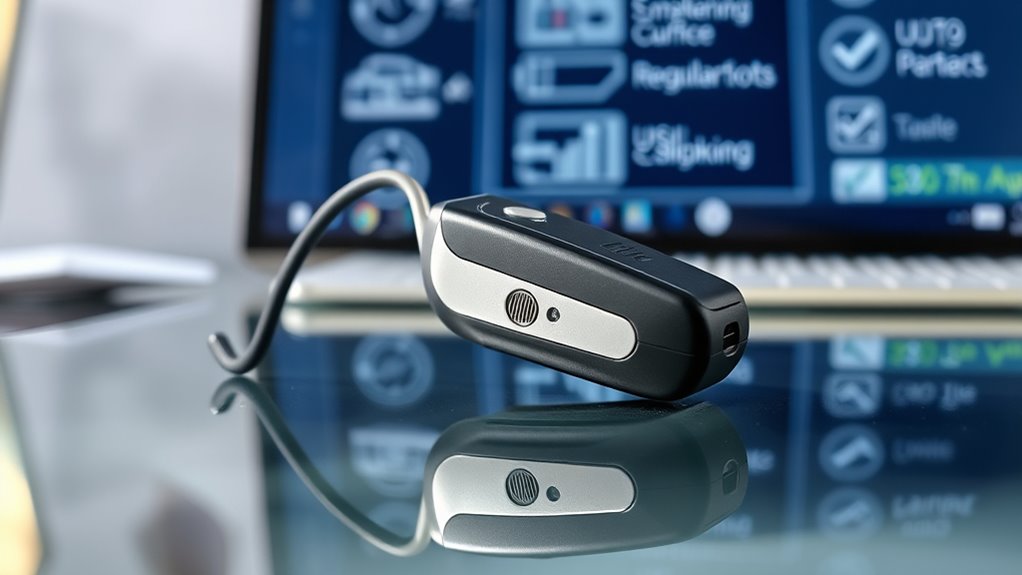
Over-the-counter (OTC) hearing devices are affordable, accessible options designed to improve hearing without a prescription or visit to a healthcare professional. The historical context shows how these devices evolved from bulky, limited technology to compact, user-friendly products. Technological advancements have played a significant role, enabling smaller devices with better sound quality, noise reduction, and personalized settings. In the past, hearing aids required complex fittings and professional adjustments, making them costly and less accessible. Today, OTC devices leverage digital technology, making hearing assistance more straightforward for consumers. This shift aims to democratize hearing care, allowing more people to access affordable solutions quickly. As technology continues to advance, OTC hearing devices are becoming increasingly sophisticated, offering a promising alternative for those seeking improved hearing without the traditional barriers. Additionally, embracing creativity and innovation in design and functionality is essential for developing future-proof hearing solutions.
The 2022 FDA Regulations and Their Impact

In 2022, the U.S. FDA set new regulations that transformed OTC hearing devices. These rules make it easier for you to access affordable hearing aids directly from stores or online, impacting hearing aid marketing strategies. Manufacturers now focus on clear labeling and safety standards, boosting consumer confidence. Insurance coverage remains limited, but some providers are beginning to recognize OTC devices as viable options. The table below highlights key impacts:
| Impact Area | What It Means for You | How It Changes the Market |
|---|---|---|
| Hearing Aid Marketing | More transparent info and wider product choices | Increased competition benefits consumers |
| Insurance Coverage | Limited coverage; more options may be self-pay | Potential for future expansion |
| Accessibility | Easier access nationwide | More convenience for buyers |
| Safety & Standards | Higher safety standards enforced | Greater trust in OTC devices |
These changes aim to make hearing aids more accessible, affordable, and trustworthy. Regulatory updates ensure ongoing improvements in device safety and consumer rights.
Eligibility Criteria for OTC Hearing Aid Buyers

To acquire an OTC hearing device, you need to meet specific eligibility criteria designed to guarantee appropriate use. Currently, the market demand for these devices is growing, prompting manufacturers to consider flexible pricing strategies that make hearing aids accessible. Typically, you must experience hearing difficulties within a certain age range and have mild to moderate hearing loss, as determined by your self-assessment or a professional evaluation. These criteria aim to ensure you use OTC devices safely and effectively. Eligibility rules focus on simplifying access while maintaining safety standards, balancing market demand with consumer protection. Understanding these requirements helps you make informed decisions and avoid potential issues related to misuse or ineffective treatment. Additionally, awareness of best hearing aid options can assist consumers in choosing the most suitable device for their needs.
Labeling and Consumer Information Requirements
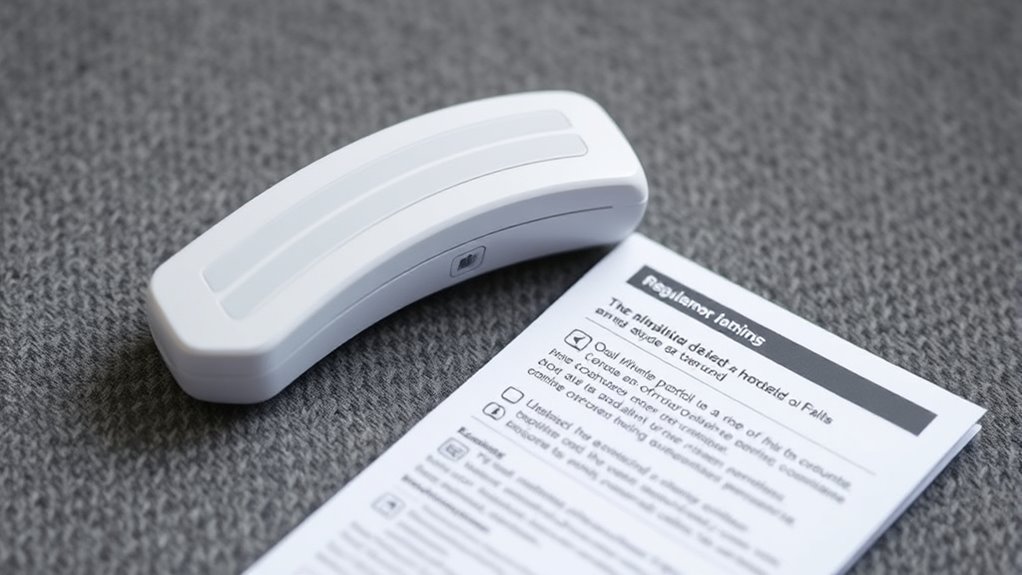
Manufacturers must meet clear labeling standards to make certain you understand a hearing device’s proper use and limitations. You should also receive straightforward instructions to help you operate the device safely and effectively. These requirements aim to empower you with all the information you need before making a purchase. Clear user consent management policies are also essential to ensure your privacy preferences are respected during the purchasing process.
Clear Labeling Standards
Clear labeling standards guarantee that over-the-counter hearing devices provide you with essential information about their use, limitations, and safety. These standards ensure labels are clear, accurate, and easy to understand, helping you make informed decisions. They also prevent misleading marketing approaches that could exaggerate benefits or hide costs. Proper labeling includes details on device features, intended use, and safety warnings, so you’re aware of what to expect. Additionally, pricing strategies must be transparent, allowing you to compare products fairly. Manufacturers are required to include straightforward instructions and warranty information. This clarity helps you evaluate options confidently and avoid unnecessary expenses. Furthermore, adherence to sound design principles in labeling can enhance the overall understanding of complex technical information. Ultimately, clear labeling standards protect consumers and promote trust in the growing OTC hearing device market.
Consumer Instructions Must Be Provided
Providing thorough consumer instructions is a key part of effective labeling standards for over-the-counter hearing devices. You should receive clear guidance on how to operate and maintain the device, ensuring proper use. These instructions must include details about product pricing, so you understand the costs involved, and information about insurance coverage options that might help offset expenses. By providing comprehensive instructions, manufacturers help you make informed decisions and avoid misuse. This not only improves user experience but also reduces the risk of damage or dissatisfaction. Additionally, transparent details about pricing and insurance ensure you can plan financially for the device. Ensuring that instructions include comprehensive safety information helps prevent potential misuse or hazards associated with incorrect operation. Overall, complete consumer instructions empower you to use over-the-counter hearing devices confidently and responsibly.
Safety Standards and Quality Assurance Measures

Safety standards and quality assurance measures guarantee that over-the-counter hearing devices are reliable and safe for consumers. Certification requirements, manufacturing quality checks, and post-market surveillance help maintain high standards. Understanding these points can help you choose devices that meet rigorous safety and quality criteria. Moreover, staying informed about AI security vulnerabilities can contribute to better awareness of safety in technological devices.
Certification Requirements
Have you ever wondered how over-the-counter hearing devices guarantee they’re safe and effective? Certification requirements guarantee these devices meet strict safety standards and quality assurance measures. These certifications can influence your cost considerations and whether insurance covers the device. Look for devices approved by recognized authorities, such as the FDA or relevant regulatory bodies. Certification involves:
- Meeting safety standards for electrical and acoustic performance
- Passing rigorous testing for durability and reliability
- Complying with labeling and usage instructions
- Undergoing quality assurance checks
- Being issued with official approval or certification marks
These requirements help protect you from subpar devices and ensure you’re investing in a safe, effective solution. Always verify the certification status before purchasing to make informed, cost-effective decisions, especially when considering insurance coverage.
Manufacturing Quality Checks
Ever wondered how manufacturers guarantee over-the-counter hearing devices are safe and reliable? They implement strict manufacturing quality checks aligned with safety standards and quality assurance measures. These checks include rigorous testing for durability, electrical safety, and sound performance before products reach consumers. Manufacturers also adopt standardized procedures to ensure consistency across batches, reducing defects and ensuring user safety. Your awareness of their quality assurance processes can influence their marketing strategies, as trustworthy products build consumer confidence. Pricing policies often reflect the costs of these quality checks, balancing affordability with safety. By adhering to regulatory safety standards and conducting thorough internal inspections, manufacturers aim to deliver reliable devices that meet consumer expectations and regulatory requirements. Additionally, leveraging advanced testing technologies helps identify potential issues early, further safeguarding user safety.
Post-Market Surveillance
Once over-the-counter hearing devices hit the market, manufacturers actively monitor their performance and safety through post-market surveillance. This process helps identify any issues that arise after distribution, ensuring ongoing safety and quality. You should pay attention to how companies track user feedback and device performance, influencing their marketing strategies to promote trust. They may also gather data to support expanding insurance coverage, making devices more accessible. Key activities include monitoring adverse events, collecting customer reviews, analyzing warranty claims, updating safety standards, and refining quality assurance measures. Additionally, manufacturers may analyze product durability data to improve future device designs. By maintaining rigorous surveillance, manufacturers protect consumers and uphold regulatory compliance, ultimately fostering confidence in over-the-counter hearing devices and encouraging wider adoption.
Differences Between OTC Devices and Prescription Hearing Aids
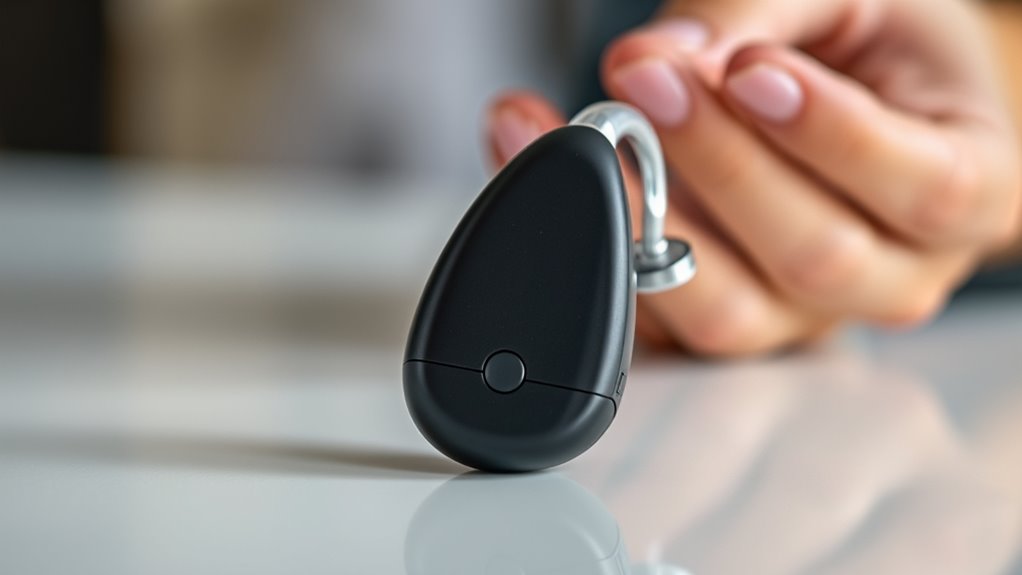
While both OTC devices and prescription hearing aids aim to improve hearing, they differ markedly in design, regulation, and customization. OTC devices are typically ready-to-wear, with limited options for personalization, making them more accessible and affordable. In terms of cost comparison, OTC devices generally cost less upfront because they don’t require professional fitting or ongoing audiologist services. Technological differences also exist; prescription hearing aids often feature advanced sound processing, customizable programs, and telehealth support, providing a tailored experience. Conversely, OTC devices usually have basic features designed to address mild hearing loss. These distinctions mean OTC devices are suitable for general use, while prescription aids are better suited for complex or severe hearing issues requiring professional assessment. Additionally, the level of product regulation impacts the safety and quality of over-the-counter options compared to prescription devices.
How to Identify Approved and Certified Products

How can you guarantee the OTC hearing device you choose is safe and effective? First, check for certification labels from recognized authorities, which ensure compliance with safety standards. Stay informed about market trends, as certified products are increasingly designed with consumer awareness in mind, emphasizing quality. Look for clear product information, including approval numbers or certifications. Research brands’ reputations and reviews from trusted sources. Verify that the device is listed on official government websites or regulatory bodies’ registries. Finally, consult with professionals if unsure—using trusted, certified products helps you avoid low-quality options and ensures your safety. Being vigilant in identifying approved devices empowers you to make informed choices in an evolving market.
Guidance for Using OTC Hearing Devices Safely

To use OTC hearing devices safely, it’s essential to learn proper fitting techniques so they work effectively and feel comfortable. Keep an eye out for any adverse effects, like discomfort or ringing, which could indicate a problem. Knowing how to recognize and respond to these issues helps protect your hearing health.
Proper Fitting Techniques
Proper fitting is essential to guarantee OTC hearing devices work effectively and comfortably. When fitting your device, consider different hearing aid styles to find what fits best and provides ideal sound quality. Always follow the manufacturer’s instructions for placement and adjustments. If you’re unsure, consulting with an audiologist can help tailor the fit and ensure proper usage. Keep these tips in mind:
- Choose the right hearing aid style for your ear shape and lifestyle
- Insert the device snugly but comfortably into your ear canal
- Adjust volume gradually to avoid discomfort
- Regularly check for proper seal to prevent feedback
- Seek professional advice if the device causes pain or doesn’t seem to fit well
Proper fitting ensures effective hearing and reduces the risk of adverse effects.
Recognizing Adverse Effects
Are you aware of the signs that indicate your OTC hearing device may be causing problems? If you experience ringing, discomfort, or muffled sounds, these could be adverse effects that require attention. Recognizing these issues early helps protect your hearing health and ensures safe device use. Increased consumer awareness is essential, especially as market access expands for OTC devices, making them more accessible. Stay vigilant and monitor how your device affects your hearing. If problems persist, consult a healthcare professional to avoid worsening issues. Being proactive reduces risks and promotes safe usage. Remember, understanding adverse effects isn’t just about recognizing symptoms but also about maintaining your overall hearing well-being as OTC devices become more widely available.
The Role of Retailers and Manufacturers in Compliance

Retailers and manufacturers play a crucial role in guaranteeing over-the-counter hearing devices meet legal and safety standards. Your retailer responsibilities include verifying that products comply with regulations and providing clear instructions for safe use. Manufacturers must prioritize compliance by designing devices that meet safety and quality requirements and ensuring accurate labeling.
- Guaranteeing products are tested and certified according to regulatory standards
- Providing accessible information on proper usage and limitations
- Maintaining transparent communication about device safety
- Conducting quality control checks regularly
- Keeping up with evolving regulations to ensure ongoing compliance
Future Developments and Ongoing Regulatory Considerations
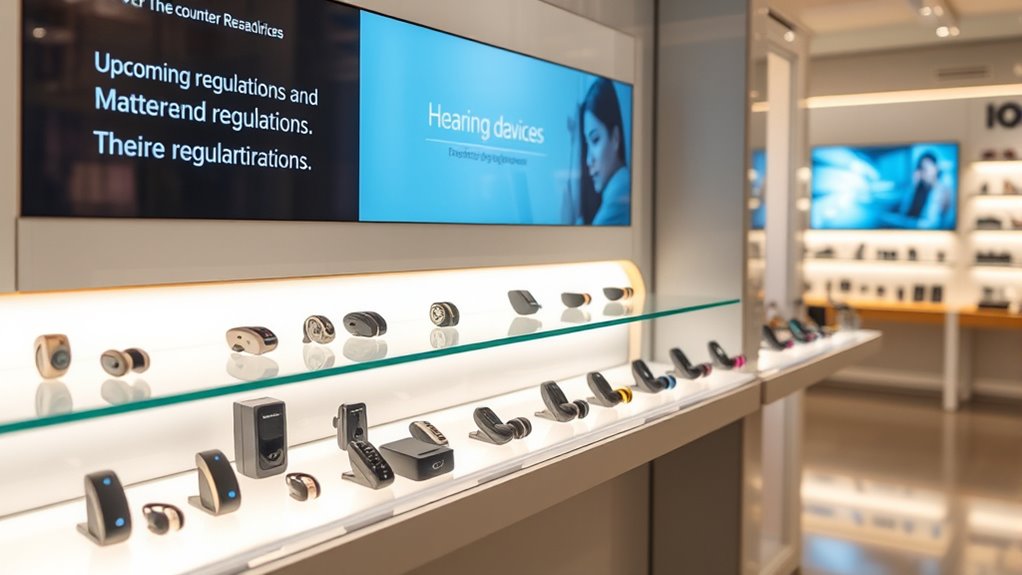
As the market for over-the-counter hearing devices continues to evolve, regulatory frameworks will need to adapt to keep pace with technological advances and increasing consumer access. Future developments will likely focus on streamlining approvals and ensuring safety without stifling innovation. You can expect ongoing regulatory considerations around quality control, efficacy, and data privacy, especially as technological innovations introduce smarter, more connected devices. Market adoption will drive the need for clearer standards and updated guidelines to support new features like AI-powered adjustments or wireless connectivity. Policymakers will need to strike a balance between encouraging innovation and protecting consumers, ensuring that regulations remain flexible yet all-encompassing. Staying informed on these evolving regulations will be essential for manufacturers, retailers, and consumers alike.
Frequently Asked Questions
Are OTC Hearing Devices Suitable for All Types of Hearing Loss?
You might wonder if OTC hearing devices suit all types of hearing loss. These devices work best for mild to moderate hearing loss and lack device customization, which is essential for severe cases. If your hearing loss is more complex or severe, you should see an audiologist for tailored solutions. OTC devices are convenient, but they aren’t a one-size-fits-all, especially when hearing loss severity varies.
How Often Should OTC Hearing Devices Be Inspected or Maintained?
You should inspect and maintain your OTC hearing devices regularly to guarantee optimal performance. Follow a consistent maintenance schedule, typically cleaning device hygiene daily and checking for any damage weekly. Regularly cleaning the ear tips and microphones helps prevent buildup and ensures clear sound. If you notice issues like reduced sound quality or discomfort, schedule a professional check-up. Proper upkeep keeps your device functioning well and extends its lifespan.
Can OTC Hearing Devices Be Customized for Individual Hearing Needs?
You might wonder if OTC hearing devices can be customized for your hearing needs. While they generally offer limited personalization options, some models include basic fitting processes to improve comfort and sound quality. However, unlike custom hearing aids, OTC devices usually don’t provide extensive fitting processes or tailored adjustments. If personalized hearing solutions are essential, consulting an audiologist for a custom device might be the better choice.
What Are the Costs Associated With OTC Hearing Devices Compared to Prescription Ones?
You might notice OTC hearing devices generally cost less than prescription ones, making them more accessible. The pricing comparison shows OTC options often range from $100 to $500, while prescription devices can cost thousands. Insurance coverage for OTC devices is usually limited or unavailable, unlike prescription models, which may be partially covered. So, if budget is a concern, OTC devices could be a cost-effective choice, but check your insurance before buying.
Are There Specific Warranties or Return Policies for OTC Hearing Devices?
You should verify the warranty policies and return procedures before purchasing OTC hearing devices, as they vary by brand and retailer. Some offer limited warranties covering repairs or replacements, while others may have no warranty at all. Return policies typically allow you to try the device for a set period, but conditions vary. Always review these policies carefully to ensure you’re comfortable with the coverage and process if issues arise.
Conclusion
Now that you know the ins and outs of OTC hearing devices, you’re armed to make smarter choices than ever before. With regulations like the 2022 FDA rules ensuring safety and quality, you can confidently navigate the hearing aid world without feeling overwhelmed. Remember, staying informed is your best tool—think of it as your superpower to protect your hearing health and avoid falling for products that aren’t up to par. Empower yourself today!

